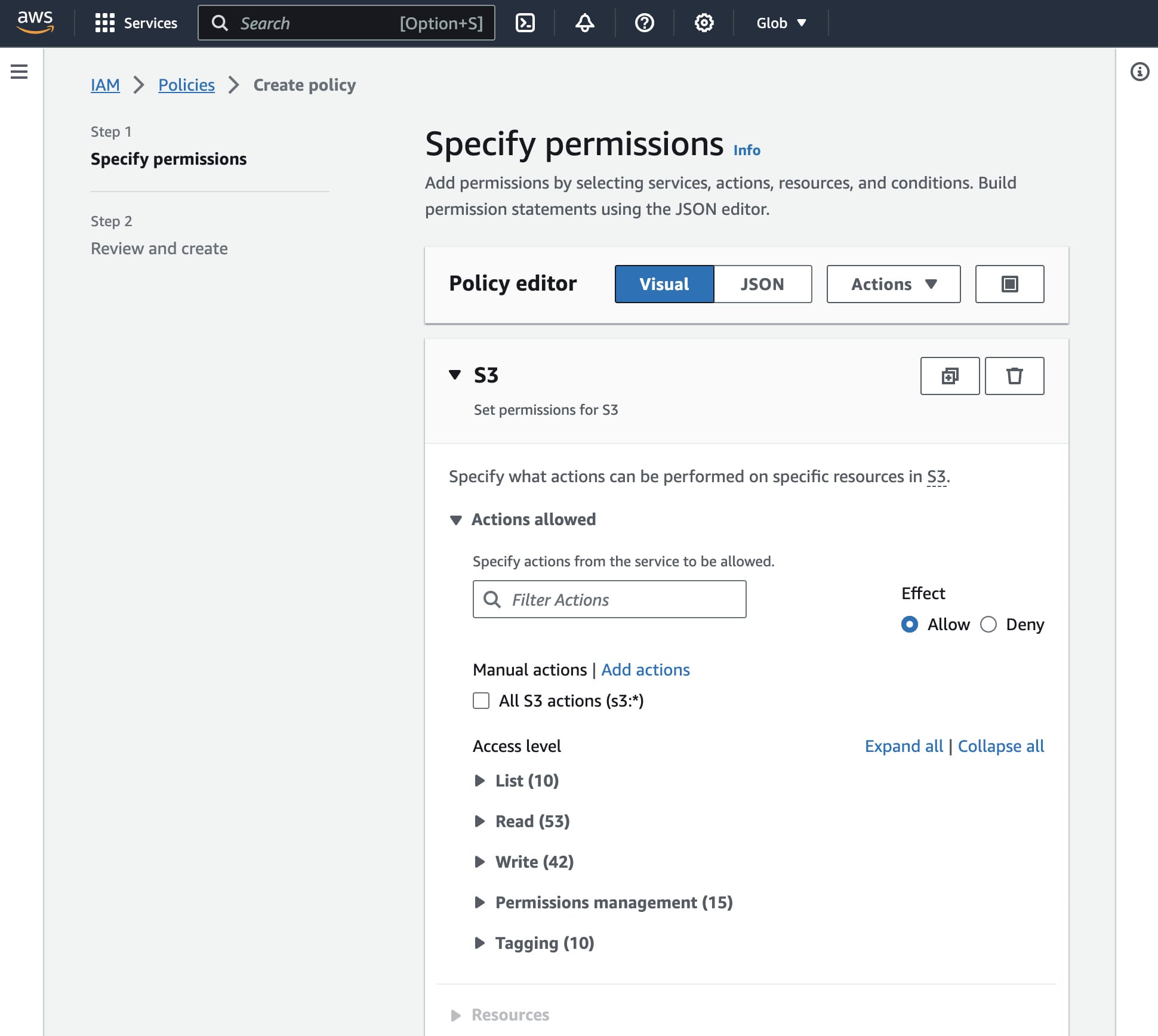While evaluating some existing IAM policies in a codebase, I found myself repeating the same steps over and over again: navigate Google and search iam actions servicename and look up information about the actions used.
Pro tip: it is much easier to just bookmark this one: Actions, resources, and condition keys for AWS services
The information I needed for my policy validation work is quite simple:
- what are all the services?
- what are all the actions a service has?
- what actions match a pattern like “Desc*” for a service?
- what are mandatory and optional resources for each action?
- what condition keys can be used?
- is the action readonly, readwrite or something else?
The first place to go to find out if this information is somehow exposed would be the AWS SDKs. I looked through the boto3 documentation on the iam service and came up empty.
After doing a lot of policies using the manual process, I remembered that AWS has a policy-editing tool in the console that seems to be using the information I was looking up manually. So I started my adventure by trying to automate my struggles.

I decided to invest some time in the policy editor, which was using some kind of API I could use to automate some things. So with the Chrome Inspect pane using the network tab, I saw a lot of http requests to:
us-east-1.console.aws.amazon.com/iamv2/api/iamv2
After some experimentation and fiddling with cookies and CSRF tokens, I found out how this undocumented API worked. So I cooked up a little Python to automate that. Since it is only 80 lines of code, I’ll share it here. I will probably make an installable Python package of it soon. The repository with the code and some examples is GitHub – binxio/aws-iamv2.
import requests
import json
import boto3
from bs4 import BeautifulSoup
# composePolicy, decomposePolicy, checkMultiMFAStatus, createX509, cuid, generateKeyPairs
methods = { "services" : lambda p: None,
"actions" : lambda p: { "serviceName": p, "RegionName": "eu-central-1" },
"resources" : lambda p: None,
"contextKeys" : lambda p: None,
"globalConditionKeys" : lambda p: None,
"getServiceLinkedRoleTemplate": lambda p: { "serviceName": p },
"policySummary" : lambda p: { "policyDocument": p },
"validate" : lambda p: { "policy": json.dumps(p), "type": "" } }
class ConsoleSession:
def __init__(self, boto3_session):
self._credentials = boto3_session.get_credentials()
self._signed_in = False
self._csrf_token = None
self._cache = {method: {} for method in methods}
self._rsession = requests.Session()
def __getattribute__(self, name):
if name in methods:
def make_lambda(method, converter):
return lambda param=None: self.get_api_result(method, converter(param))
return make_lambda(name, methods[name])
else:
return object.__getattribute__(self, name)
def signin(self):
token = json.loads(self._rsession.get(
"https://signin.aws.amazon.com/federation",
params={
"Action": "getSigninToken",
"Session": json.dumps({
"sessionId": self._credentials.access_key,
"sessionKey": self._credentials.secret_key,
"sessionToken": self._credentials.token
})
}
).text)["SigninToken"]
self._rsession.get(
"https://signin.aws.amazon.com/federation",
params={
"Action": "login",
"Issuer": None,
"Destination": "https://console.aws.amazon.com/",
"SigninToken": token
}
)
for m in BeautifulSoup(self._rsession.get(
"https://us-east-1.console.aws.amazon.com/iamv2/home#",
params={ "region": "eu-central-1", "state": "hashArgs" }
).text, "html.parser").find_all("meta"):
if m.get("name") == "awsc-csrf-token":
self._csrf_token = m["content"]
self._signed_in = True
def get_api_result(self, path, param=None):
not self._signed_in and self.signin()
params = json.dumps(param)
if self._cache[path].get(params, None):
return self._cache[path][params]
self._cache[path][params] = json.loads(self._rsession.post(
"https://us-east-1.console.aws.amazon.com/iamv2/api/iamv2",
headers={
"Content-Type": "application/json",
"X-CSRF-Token": self._csrf_token,
},
data=json.dumps({
"headers": { "Content-Type": "application/json" },
"path": f"/prod/{path}",
"method": "POST",
"region": "us-east-1",
"params": {},
**({ "contentString": params } if params else {})
})
).text)
return self._cache[path][params]
A few things about this code:
- The
ConsoleSessionclass takes aboto3.Sessionas input. This session needs no actual rights to AWS. - The code might look a bit strange because I wanted to make it as a dynamic class so I only had to add one line to implement an extra API endpoint. This uses the
__getattribute__override and themethodsobject. - I use the
requestsmodule and start arequests.Session()that does much of the heavy lifting handling cookies needed for the http requests to succeed. - To fetch the
awsc-csrf-tokenfrom the page I useBeautifulSoup - The method in
methodswere not all discover by me, I did a search oniamv2on github and found some json files that were already detailing this API. - Since the information retrieved for the API calls I needed does not change per request I implemented a simple caching feature. For some methods like
policySummaryandvalidatethis might not be optimal.
The actual signing in is done using three HTTP requests:
- Getting a
SigninTokenfromsignin.aws.amazon.com/federation - Use the token to
logintohttps://console.aws.amazon.com/ - Retrieve
https://us-east-1.console.aws.amazon.com/iamv2/home#to get theawsc-csrf-tokenfrom the page.
Example usage
The code below demonstrates example usage:
import boto3
from iamv2 import ConsoleSession
import re
awssvcs = {}
console_session = None
def get_iam_info():
global console_session
boto_session = boto3.Session(region_name='us-east-1')
console_session = ConsoleSession(boto_session)
services = console_session.services()
for service in services:
name = service["serviceName"]
if name not in awssvcs:
awssvcs[name] = { "parts": [] }
awssvcs[name]["parts"].append(service)
def get_statement_actions(statement):
result = []
actions = statement.get("Action") or statement.get("NotAction")
reverse = "NotAction" in statement
reverse = not reverse if statement["Effect"] == "Deny" else reverse
actions = [actions] if isinstance(actions, str) else actions
for action in actions:
service, act = action.split(':')
if "Actions" not in awssvcs[service]:
awssvcs[service]["Actions"] = console_session.actions(awssvcs[service]["parts"][0]["serviceKeyName"])
actrgx = act.replace('*', '[A-Za-z]+')
for svc_action in awssvcs[service]["Actions"]:
if bool(re.match(actrgx, svc_action["actionName"], flags=re.IGNORECASE)) ^ reverse:
result.append(svc_action)
return result
def get_policy_actions(policy):
for statement in policy["Statement"]:
yield get_statement_actions(statement)
get_policy_actions will simply list all the actions allowed by the statements in the policy. Here it is in action:
policy = {
"Version": "2012-10-17",
"Statement": [{
"Sid": "ReadOnlyCloudTrail",
"Effect": "Deny",
"NotAction": "cloudtrail:De*",
"Resource": "*"
}]
}
get_iam_info()
for statement_actions in get_policy_actions(policy):
statement_actions = sorted(statement_actions, key=lambda x: x["actionName"])
for action in statement_actions:
print(f'{action["actionName"]:40} {", ".join(action["actionGroups"])}')
This will give the following list:
DeleteChannel ReadWrite
DeleteEventDataStore ReadWrite
DeleteResourcePolicy ReadWrite
DeleteServiceLinkedChannel ReadWrite
DeleteTrail ReadWrite
DeregisterOrganizationDelegatedAdmin ReadWrite
DescribeQuery ReadOnly, ReadWrite
DescribeTrails ReadOnly, ReadWrite
You can see that this policy allows some actions that are not read-only. You could use this code in tests being evaluated in your pipeline to make sure you never accidentally allow non-readonly actions in this policy.
Future
I will make an installable Python package from the API part. Also, I have some ideas for some neat policy tools:
- check for common mistakes in policies.
- generate readonly service statements for in a permissions boundary




